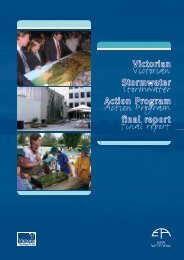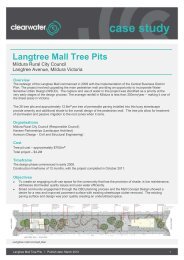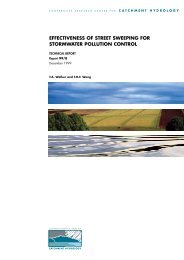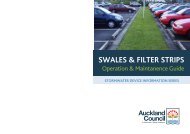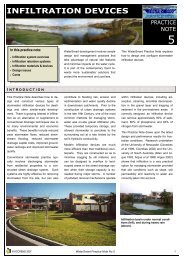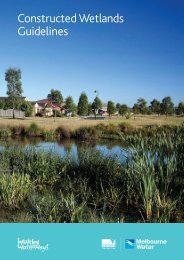Hydraulic performance of biofilter systems for stormwater management
Hydraulic performance of biofilter systems for stormwater management
Hydraulic performance of biofilter systems for stormwater management
You also want an ePaper? Increase the reach of your titles
YUMPU automatically turns print PDFs into web optimized ePapers that Google loves.
(1) a single ring shallow infiltrometer (referred to herein as K fs shallow ), and<br />
(2) a deep ring infiltrometer (herein referred to as K fs deep ).<br />
Laboratory measurements <strong>of</strong> hydraulic conductivity were also conducted on two<br />
types <strong>of</strong> samples:<br />
(1) surface samples (K lab surf ), and<br />
(2) samples taken from deep in the filter media (at a depth <strong>of</strong> approximately 150<br />
mm below the surface - referred to as K lab deep ini )<br />
Whilst the surface measurement reflects the current effective hydraulic<br />
conductivity <strong>of</strong> the system, the deep sample provides an estimate <strong>of</strong> the initial hydraulic<br />
conductivity <strong>of</strong> the media. Methods used <strong>for</strong> determining each <strong>of</strong> these measures are<br />
described in more detail in subsequent sections.<br />
Single ring field infiltration test (shallow test)<br />
The single ring infiltrometer test has been widely described in the literature (see<br />
Reynolds and Elrick, 1990, Youngs et al. 1993 <strong>for</strong> example) and thus only a brief<br />
summary is given here. This method measures the hydraulic conductivity at the surface<br />
<strong>of</strong> the soil (and thus is most appropriate when the hydraulic conductivity is controlled<br />
by a limiting layer at the media surface).<br />
The single ring infiltrometer consists <strong>of</strong> a small plastic ring, with a diameter <strong>of</strong><br />
100 mm that is driven 50 mm into the soil (Figure 2). It is a constant head test that is<br />
conducted <strong>for</strong> two different pressure heads (50 mm and 150 mm). The experiment is<br />
stopped when the infiltration rate is considered steady (i.e. when the volume poured per<br />
time interval remains constant <strong>for</strong> at least 20 minutes).<br />
In order to calculate K fs , a ‘Gardner’s’ behaviour <strong>for</strong> the soil was assumed<br />
(Gardner, 1958 in Youngs et al. 1993):<br />
K(<br />
h)<br />
= K fs<br />
e<br />
αh<br />
Eq. 1<br />
Where K - the hydraulic conductivity, h - the negative pressure head and α - a soil pore<br />
structure parameter.<br />
10




